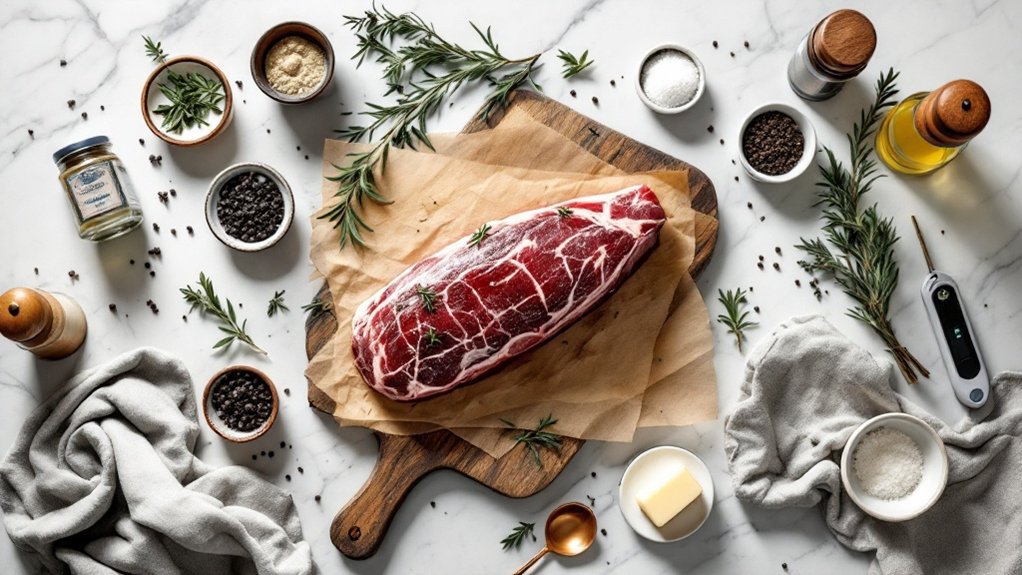
When you combine the earthy richness of juniper-crusted venison with the sweet-tart elegance of blackberry-sage butter, you’re crafting more than just a meal – you’re recreating a timeless connection to nature’s pantry. This dish carries whispers of misty forest mornings and late-summer harvests, bringing together wild game and foraged botanicals in a way that’ll transport you straight to a cozy hunting lodge. There’s a story behind every ingredient, and it’s one you won’t want to miss.
However, if you’re eager to create a stunning venison dish that’ll transport you to a woodland feast, you’ll want to capture the beauty of this rustic yet elegant meal.
When you plate this juniper-crusted venison loin, drizzled with glossy blackberry-sage butter, you’re crafting more than just dinner – you’re creating a moment worth remembering.
The deep burgundy of the perfectly cooked meat, the dark purple bursts of wild blackberries, and the emerald flecks of fresh sage create a picture-perfect presentation that’ll have your guests reaching for their phones before their forks.
Let’s dive into making this showstopping dish that brings the forest to your table.
History
Throughout history, venison has graced the tables of both royalty and common folk, marking its enduring legacy as one of humanity’s most cherished proteins.
You’ll find tales of medieval kings hosting grand feasts where venison took center stage, while humble hunters sustained their families through harsh winters with this prized meat.
In ancient times, you’d have discovered venison being prepared with juniper berries in Germanic tribes, a tradition that’s carried forward to modern cooking.
If you’ve ever wondered about your ancestors’ connection to this noble meat, you’ll be fascinated to learn that Native Americans taught early European settlers their venison preparation techniques, including smoking and drying methods that you might still use today.
These time-tested practices have evolved into the sophisticated recipes we now treasure in our kitchens.
Recipe

Venison loin, also known as backstrap, is one of the most prized cuts from deer meat, known for its exceptional tenderness and rich, gamey flavor. When prepared correctly, this lean cut of meat can rival the finest beef tenderloin in both taste and texture.
This recipe transforms the venison loin into an elegant yet simple dish that highlights the meat’s natural qualities while ensuring it remains juicy and flavorful. The key is to avoid overcooking, as venison is naturally lean and can become tough if cooked beyond medium-rare.
- 2 pounds venison loin
- 2 tablespoons olive oil
- 4 cloves garlic, minced
- 2 sprigs fresh rosemary
- 2 sprigs fresh thyme
- 2 tablespoons butter
- 1 tablespoon black pepper
- 1 tablespoon kosher salt
- 1 tablespoon Dijon mustard
Remove the venison from refrigeration 30 minutes before cooking to reach room temperature. Pat dry and season with salt and pepper.
Heat olive oil in a large cast-iron skillet over medium-high heat. Sear the loin on all sides until browned, about 2-3 minutes per side. Add butter, garlic, and herbs to the pan. Baste the meat with the melted butter mixture while cooking until internal temperature reaches 125°F for medium-rare.
Let rest for 10 minutes before slicing.
For a healthier version, replace butter with ghee or additional olive oil. To enhance flavor and tenderness, consider marinating the venison overnight in red wine, garlic, and herbs.
If cooking for those new to game meat, you can reduce the gamey flavor by soaking the meat in buttermilk for 12 hours before cooking. Always use a meat thermometer to ensure proper doneness, as venison can quickly become overcooked.
Final Thoughts
While mastering the art of cooking venison loin takes practice and patience, you’ll find that the rewards of creating this exquisite dish are well worth the effort.
As you gather around the table with family and friends, you’ll notice how the juniper berry crust creates an unforgettable aroma that fills the room, while the blackberry-sage butter adds a sophisticated touch that elevates this wild game dish to restaurant quality.
Don’t be discouraged if your first attempt isn’t perfect – each time you prepare this recipe, you’ll discover new nuances in flavors and timing that will help you refine your technique.
Remember that cooking with foraged ingredients connects you to nature’s bounty and ancient culinary traditions, making each meal a celebration of both skill and simplicity.


